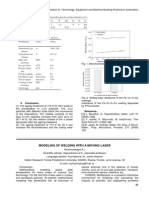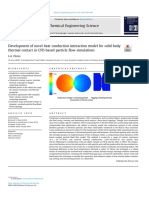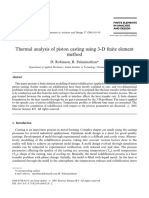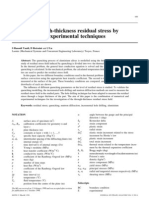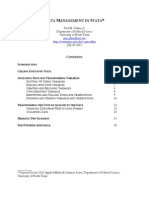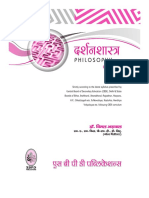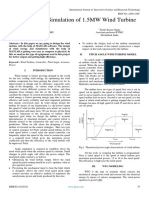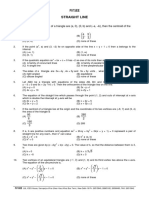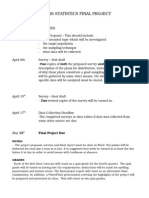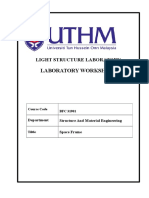Professional Documents
Culture Documents
A Rigorous Experimental Technique To Measure The Thermal Diffusivity of Metals in Different 3D Forms
Original Title
Copyright
Available Formats
Share this document
Did you find this document useful?
Is this content inappropriate?
Report this DocumentCopyright:
Available Formats
A Rigorous Experimental Technique To Measure The Thermal Diffusivity of Metals in Different 3D Forms
Copyright:
Available Formats
Volume 7, Issue 10, October – 2022 International Journal of Innovative Science and Research Technology
ISSN No:-2456-2165
A Rigorous Experimental Technique to Measure the
Thermal Diffusivity of Metals in Different 3D Forms
Dr. Ismail Abbas
Senior lecturer at MTC, Cairo
Abstract:- This present work is a continuation and other words, the total thermal energy stored in an object
validation of the results explained in a previous paper during its cooling curve is equal to the temperature at its CM
titled A Rigorous Experimental Technique for Measuring multiplied by the total number of free nodes in the grid (n).
the Thermal Diffusivity of Metals and goes further to
describe the notion of dimensionless time tD practical for This suggests the extension of the proposed experimental
solving the energy-density field distribution in 4D space. technique from cubic shaped objects to other regular shapes
Moreover, the notion of dimensionless time and statistical such as cylinders, hemispheres, pyramids, etc. by finding the
characteristic length of the 3D material object is cooling curve of the tested object at its CM and by relating its
introduced, defined and proved effective. exponent to the thermal diffusivity as explained in the
theoretical part.
We have carried out a preliminary experimental
investigation and a theoretical analysis on five 3D Recall that the so-called Cairo numerical technique
geometric objects of different shapes in aluminum and transforms continuous real time t into dimensionless discrete
steel and the results obtained for the thermal diffusivity time tD. tD is equal to N f where N is the number of iterations
are in good agreement with the thermal tables. performed on the transition matrix B through its chain and f
is a statistical factor.
I. INTRODUCTION
The dimensionless diffusive time is equal to the number of
This article is a generalization to non-cubic forms of the iterations N multiplied by a statistical factor f.
theory and experiment explained in a previous article entitled The transformation from real continuous time to the
A rigorous experimental technique for measuring the thermal dimensionless discrete time domain via the matrix B and vice
diffusivity of metals [1,2] and goes further by describing the versa requires the introduction of four parameters depending
notion of dimensionless time tD practical for solving energy on the geometric shape of the body and its thermal diffusivity.
density distribution in 4D space (x, y, z, t).
II. THEORY
In reference 1 we limited the proposed experimental
technique to experimental measurements of thermal Below is the general form of the partial differential
diffusivity in aluminum and steel in cubic shapes, while in the equation for the time evolution of the energy density U in 3D
present work we go further in other shapes. Regular shapes geometric space,
such as cylinders, hemispheres and pyramidal shapes have d / dt (partial) U (x,y,z,t) = D Nabla2 U (x,y,z,t) + S
been studied. (x,y,z,t) .. . . . . . . (1)
To be precise, the previous works [1,5,6] are based on In normal conventions. Equation (1) is subjected to
the numerical statistical method called Cairo technique which Dirichlet boundary conditions BC and arbitrary initial
predicts an exponential decay of the energy density in a conditions IC.
bounded medium and relates the exponent to the physical and
geometric properties of the object, under test. In fact, equation (1) characterizes the time evolution of
the energy density in real time t and in the 3D geometric space
Moreover, we assume that the general heat diffusion x,y,z where in the SI system (MKS) the unit of t is the second
PDE (Eq 1) cannot practically be solved numerically in real (s), that of x,y,z is meter (m) and that of thermal diffusivity is
time. Finite difference computation (FDM) methods of real- m^2/s.
time numerical solutions are extremely time-consuming and
prone to instability and inaccuracy, while the same in Our task is to show how to describe the solution in
dimensionless time tD are short, fast, and the stability and dimensionless time tD. In the proposed numerical method
accuracy are assured. called Cairo technique, this is done via B-Matrix strings
where the real time t is completely lost.
In the present experimental technique proposed to
measure the thermal diffusivity of metals in different 3D The notion of dimensionless time tD was recently
forms, we assume that, The spatio-temporal average of the introduced and described in signal processing theory [7].
energy density called the center of the energy density field
U(x,y,z,t) in the object under test coincides with its center of In the phenomena of diffusion in bounded objects, the
mass CM along the time evolution of its cooling curve. In dimensionless time is defined equal to f N where N is the
IJISRT22OCT077 www.ijisrt.com 390
Volume 7, Issue 10, October – 2022 International Journal of Innovative Science and Research Technology
ISSN No:-2456-2165
whole number of operations or time step iterations carried out time domain. The statistical transition matrix B which
on the transition matrix B 1,2,3 . .. N and f is a scalar quantity contains all the information to solve Equation 1 in the time-
depending on the physical and geometric properties of the dependent 3D geometry of the cube in Figure 1 is specified
tested object. via a procedure similar to that followed in previous work
where the entries in the matrix B27X27 must be expressed in
The proposed experimental technique itself is not the following form [1,2,5,6],
complicated and can be summarized in the following five
consecutive steps, 27X27 B-Matrix inputs
i-Perform the experimental results of the temperature cooling Line1: RO 1/6-RO/6 0.0000 1/6- RO 1/6-RO/6 0.0000 0.0000
curve at the center of mass CM of the tested object and thus 0.0000 0.00001/6-RO/6 0.0000 0.0000 0.0000 0.0000 0.0000
find the real time - half-time decay value, i.e. T1/2, T1/4, T1/8 0.0000 0.0000 0.00000.0000 0.0000 0.00000.0000 0.0000
etc [1,2]. 0.0000 0.0000 0.0000 0.0000
Line 2: 1/6-RO/6 RO 1/6-RO/6 0.0000 1/6-RO/6 0.0000
ii- Calculate the statistical characteristic length of the tested 0.0000 0.0000 0.0000.0000 1/6-RO/6 0.0000 0.0000 0.0000
object Lc via the semi-imperial formula (2), [1,2] 0.0000 0.0000 0.0000 0.00000.00000.0000 0.0000 0.0000
Lc = {6*Volume of object V / Area of object A} . . . .(2) 0.0000 0.0000 0.0000 0.0000 0.0000
The statistical factor f emerges from another semi-imperial Line 3: 0.0000 1/6-RO/6 RO 0.0000 0.0000 1/6RO/6 0.0000
formula, 0.0000 0.00000.00000.0000 1/6-RO/6 0.0000 0.0000 0.0000
f = Pie /2. = 1.571 0.0000 0.0000 0.00000.0000 0.00000.0000 0.0000 0.0000
0.0000 0.0000 0.0000 0.0000
In fact, the characteristic length is of great importance . . . . . . . . . . . . . . . . . . . . . . . . . . . . . . . . . . .\
in itself since the experimental temperature of the real-time Line 14: 0.0000 0.0000 0.0000 0.0000 1/6-RO/6 0.0000
cooling curve at the center of mass CM is described by, 0.0000 0.00000.00000.0000 1/6-RO/6 0.0000 1/6-RO/6 RO
T(t)=T(0).Exp (- D . f . t /Lc^2) . . . . . (3) 1/6-RO/6 0.0000 1/6-RO/60.00000.0000 0.0000 0.0000
0.0000 1/6-RO/6 0.0000 0.0000 0.0000 0.0000. . . . . .. . . . . .
Equation 3 is simply a consequence of defining the exponent . . . . . . . . . . . . . . . . . . . . . . . . .. . . . . . . . . . . . . . . . . . . . . . . . .
of the cooling curve as the heat left per second dU/dt divided ..........
by the heat stored U. Line 25: 0.0000 0.0000 0.0000 0.0000 0.0000 0.0000 0.0000
0.0000 0.00000.00000.0000 0.0000 0.0000 0.0000 0.0000
Equations 2 and 3 suggest an important geometric 1/6-RO/6 0.0000 0.00000.0000 0.00000.0000 1/6-RO/6
physical rule, 0.0000 0.0000 RO 1/6-RO/6 0.0000
Line 26: 0.0000 0.0000 0.0000 0.0000 0.0000 0.0000 0.0000
Two 3D bodies of different shapes cannot have the same 0.0000 0.00000.00000.0000 0.0000 0.0000 0.0000 0.0000
volume to area ratio (V/A) unless both have exactly the 0.0000 1/6-RO/6 0.00000.0000 0.00000.0000 0.0000 1/6-
same volume and area. RO/6 0.0000 1/6-RO/6 RO 1/6-RO/6
It is simple to show that the half-time decay interval is given Line 27: 0.0000 0.0000 0.0000 0.0000 0.0000 0.0000 0.0000
by, 0.0000 0.00000.00000.0000 0.0000 0.0000 0.0000 0.0000
T1/2= Log 2. Lc^2/D f . . . (4) 0.0000 0.0000 1/6-RO/60.0000 0.00000.0000 0.0000 0.0000
Obviously Log 2. = 0.693 1/6-RO/6 0.0000 1/6-RO/6 RO
with RO = 0.22 for steel and 0.13 for aluminum as shown in
In other words, the required thermal diffusivity will be given references 1 and 2.
by, In order not to worry too much about the details of the theory,
D= 0.693 *Lc^2 / (T1/2 * f ) . . . (5) let us present the following five illustrative experimental
applications with their experimental setups and experimental
Note that the statistical characteristic length Lc can be found results.
mathematically or experimentally as explained in references
1,2. III. EXPERIMENTAL SETUP AND
iv- Plot the experimental real-time cooling curve EXPERIMENTAL RESULTS
T(t)=T(0) .Exp(- D f t /Lc^2),
We move on to five different applications on different
Know the value of T1/2 and therefore calculate the 3D shapes, cubic and non-cubic, Al and steel where the tank
equivalent thermal diffusivity D using formula 5. cold water temperature is zero centigrade.
v- Also plot the dimensionless cooling time curve
proposed by the transition matrix B chains by choosing the The experimental setup is described in detail in
appropriate value of RO and compare their fit with the Reference 1 along with the composition of steel and
experimental results. aluminum used as the test material.
In this paper, we have arbitrarily chosen to apply the B In all five experiments, the hot water reservoir was
27X27 transition matrix as the transition to the dimensionless maintained at 76 C and the cold reservoir at 0 C.
IJISRT22OCT077 www.ijisrt.com 391
Volume 7, Issue 10, October – 2022 International Journal of Innovative Science and Research Technology
ISSN No:-2456-2165
III(a)- Steel cube of 10 cm side Fig 1.
Fig 1. Steel cube with sides of 10 cm with holes and resistance thermometers.
The results of temperature T in centigrade at CM vs time in seconds is presented in Table III-a.
Table III-a , Cooling curve for steel cube 10 cm side length
t(sec) 0 30 60 90 120 150 180 210 240 300 360 420 480 540 600
T(c) 76 58 48 39 31 25.2 20.2 15.8 12.9 10.9 9.1 8.4 7.9 7.4 ---
We conclude from table III-a that T1/2 is close to 100 s.
Eq 2 yields Lc =10 cm for steel cube ie, equal to its side length
Finally , using Eq 5, ,then the value of the thermal diffusivity for steel equals
D= Lc^2. Log 2/ (T1/2.*Pie/2)
D=1 E-2*0.693 / (100*1.57) =44.2 E-6 m^2/s in good agreement with the thermal tables [8].
IJISRT22OCT077 www.ijisrt.com 392
Volume 7, Issue 10, October – 2022 International Journal of Innovative Science and Research Technology
ISSN No:-2456-2165
III(b)-Aluminum cube of 10 cm side Fig 2.
Fig 2. Aluminum Cube of side length 10 cm.
The results of temperature T in centigrade at CM vs time in III(c). Aluminum cylinder of mass 2.61 Kg, a radius R of
seconds is presented in Table III-b. 14.8 and a length L of 14.8 cm.Fig.3
Table III-b , Cooling curve for Aluminum cube
10 cm side length
t(sec) 0 30 60 90 120 150 180 210 240 300 360
420 480 540 600
T(c) 76 45 33 26.5 23 20 17.6 15.5 13.8 11.9 10.
8.2 7.95 7.4 6.95
We conclude from table III-b that T1/2 is close to 45 s.
Equation 2 gives Lc = 10 cm for an aluminum cube, i.e. equal
to the length of its side.
Finally , using Eq 5, ,then the value of the thermal diffusivity
for Aluminum equals
D= Lc^2. Log 2/ (T1/2.*Pie/2)
D=1 E-2*0.693 /(45*1.57) =98 E-6 m^2/s
in good agreement with thermal tables[7]. Fig.3 Regular cylinder with circular base of radius R and
length L.
IJISRT22OCT077 www.ijisrt.com 393
Volume 7, Issue 10, October – 2022 International Journal of Innovative Science and Research Technology
ISSN No:-2456-2165
The results of temperature T in centigrade at CM vs time Easy to calculate the surface area of the cylinder as
in seconds is presented in Table III-c nearly 600 cm^2 and
Table III-c , Cooling curve for Aluminum cylinder 14.0 Volume of the cylinder is nearly 1000 cm^3 which are
cm diameter and 6.5 cm length. the same as those of the preceding cube of 10 cm side length.
t(sec) 0 30 60 90 120 150 180 210 240 300 360 Cooling curve for Aluminum cylinder (Table III-c)14.0
420 480 540 600 cm diameter and 6.5 cm length is similar to that of the cube
T(c) 76 44 32 26. 23 20 17.2 15.6 13.8 11.6 (Table III-b) as Equation 3 predicts.
9.8 8.6 7.9 7.4 6.9
Obviously the calculated thermal diffusivity D is the same ,
We conclude from table III-c that T1/2 is close to 45 s D Alumium= 0.98 E-4 m^2/s.
close to that of the Aluminum cube as expected.
III(d). Aluminum pyramid with a mass of 6.5 Kg, a square base of 20 cm and a height of 19 cm.Fig.4
Fig.4 Regular pyramid with square base
IJISRT22OCT077 www.ijisrt.com 394
Volume 7, Issue 10, October – 2022 International Journal of Innovative Science and Research Technology
ISSN No:-2456-2165
The results of temperature T in centigrade at CM vs time Easy to calculate the surface area of the pyramid as nearly
in seconds is presented in Table III-d. 1160 cm^2 and
Volume of the pyramid is nearly 2500 cm^3 .
Table III-d , Cooling curve for Aluminum pyramid with The characteristic length for the pyramid is 6 V/A=13.6 cm.
a square base of 20 cm and a height of 19 cm.Fig.4 Cooling curve for Aluminum pyramid (Table III-d) at its CM
t(sec) 0 30 60 90 120 150 180 210 240 300 is similar to that of an equivalent cube of side length 13.6 as
360 420 480 540 600 Equation 3 predicts.
T(c) 76 49 38.5 28 26 22.6 18.3 16.8 15.7 13.5
12.6 8.6 12 11.3 9.9 It is simple to calculate thermal diffusivity D from Eq. 5,
D= 0.693 *Lc^2 /(T1/2*f) = 132 E-6 m^2/s
We conclude from table III-d that T1/2 is close to 62 s which is slightly higher than that of thermal tables.
III(e). Aluminum half-sphere with a mass of 1.8 Kg and a diameter of 14.5 cm.Fig.5
Fig.5 Regular aluminum hemisphere with circular base
IJISRT22OCT077 www.ijisrt.com 395
Volume 7, Issue 10, October – 2022 International Journal of Innovative Science and Research Technology
ISSN No:-2456-2165
The results of temperature T in centigrade at CM vs time REFERENCES
in seconds is presented in Table III-e.
[1]. I.M. Abbas, IJISRT review , A rigorous experimental
Table III-e , Cooling curve for Aluminum hemisphere technique for measuring thermal diffusivity of metals,
with a mass of 1.8 Kg and circular base of 14.5 cm. Aug 2022.
t(sec) 0 30 60 90 120 150 180 210 240 300 [2]. I.M. Abbas, Researchgate , A rigorous experimental
360 420 480 540 600 technique to measure the thermal diffusivity of metals
T(c) 76 36 25.5 20.5 17 14.6 12.5 11 9.7 8.7 7.6 ,Oct 2022.
6.6 5.9 4.9 4.3 [3]. Matthew Sullivan et al, An experiment on the dynamics
of thermal diffusion
We conclude from table III-e that T1/2 is close to 29 s [4]. July 2008, American Journal of Physics 76(7)
Easy to calculate the area of the hemisphere to nearly 495 DOI:10.1119/1.2888544
cm^2 and [5]. Project: An experiment on the dynamics of thermal
its volume is nearly 700 cm^3.The characteristic length Lc diffusion.
for the hemisphere is, [6]. Riad Abdul Abas, Experimental Studies of the Thermal
Lc= 6 V/A=8.48 cm. Diffusivities concerning
Cooling curve for Aluminum halfsphere (Table III-e) at its [7]. Some Industrially Important Systems, Doctoral
CM is similar to that of an equivalent cube of side length 8.48 Dissertation, School of Industrial Engineering and
as Equation 3 predicts. Management, Department of Material Science and
Engineering
It is simple to calculate thermal diffusivity D from Eq. 5, [8]. Royal Institute of Technology,SE-100 44 Stockholm
D= 0.693 *Lc^2 /(T1/2*f) = 109 E-6 m^2/s ,Sweden.
which is close to that given by thermal tables [8]. [9]. 5-I.M.Abbas, IJISRT review , A Statistical Numerical
Solution To Poisson and Laplace PDE, Oct 2020.
IV. CONCLUSION [10]. I.M.Abbas, IJISRT revi ew , A time-dependent
numerical statistical solution of the partial differential
The presented experimental results and mathematical heat diffusion equation, Jan 2021.
calculations provide a rigorous experimental basis for [11]. Alan V. Oppenheim, Alan S. Willsky, Signals &
measuring the thermal diffusivity of metals and thus prove Systems, Second Edition,
the accuracy and usefulness of the numerical method called [12]. Massachussets Instiute of Technology, Boston
the Cairo technique. University, 1996.
[13]. Thermal Diffusivity Table - Engineers Edge.`
The introduction of the so-called characteristic length [14]. -I.M. Abbas, ijisrt, Volume 5 - 2020, Issue 11 – Nov, A
Lc has proven to be useful in predicting the time dependence Numerical Statistical Solution to the Laplace and
of temperature in the cooling phase of regularly shaped Poisson Partial Differential Equations.
objects and, therefore, in finding their thermal diffusivity. [15]. 10-I.M. Abbas et al, IEEE.1996,Pseudo-spark
discharge. Transactions on Plasma Science 24(3):1106
The dimensionless time tD inherent in the B-Matrix - 1119 ,DOI: 10.1109/27.533119
chain solution of time-dependent energy density scattering in
3D geometric objects has been shown to be consistent, stable,
fast, and accurate.
The theoretical and experimental results produced in
this article are consistent and suggest to introduce and
develop a generalized or unified theory to solve the problems
of energy density diffusion (thermal energy, electric potential
energy, sound kinetic energy, etc.) in 4D bounded media.
NB. All calculations in this article were produced
through the author's double precision algorithm to ensure
maximum accuracy, as followed by Ref. 10 for example
IJISRT22OCT077 www.ijisrt.com 396
You might also like
- A Rigorous Experimental Technique For Measuring The Thermal Diffusivity of MetalsDocument6 pagesA Rigorous Experimental Technique For Measuring The Thermal Diffusivity of MetalsInternational Journal of Innovative Science and Research TechnologyNo ratings yet
- In The Heat DiffusionConduction Equation, How To Extend The Validity of The Dirichlet Boundary Conditions To More Than One Dimensional Geometric SpaceDocument19 pagesIn The Heat DiffusionConduction Equation, How To Extend The Validity of The Dirichlet Boundary Conditions To More Than One Dimensional Geometric SpaceInternational Journal of Innovative Science and Research TechnologyNo ratings yet
- Cambridge Institute of Technology: Department of Mechanical Engineering Heat Transfer Important Theory QuestionsDocument4 pagesCambridge Institute of Technology: Department of Mechanical Engineering Heat Transfer Important Theory QuestionsrichardNo ratings yet
- Mathematical Modeling of Heat Transfer Processes in Energy-Saving Solar Energy SystemsDocument4 pagesMathematical Modeling of Heat Transfer Processes in Energy-Saving Solar Energy SystemserpublicationNo ratings yet
- Effect of Processing Parameters On Thermal Phenomena in Direct Laser Metallic Powder DepositionDocument6 pagesEffect of Processing Parameters On Thermal Phenomena in Direct Laser Metallic Powder Depositionsajjad moattarNo ratings yet
- Mathematical Modelling of Steel QuenchingDocument6 pagesMathematical Modelling of Steel Quenchingmanashree02No ratings yet
- Prediction of Mechanical Properties and Microstructure Distribution of Quenched and Tempered Steel ShaftDocument10 pagesPrediction of Mechanical Properties and Microstructure Distribution of Quenched and Tempered Steel ShaftfdcarazoNo ratings yet
- A New Concept For Finite Element Simulation of Induction HeatingDocument5 pagesA New Concept For Finite Element Simulation of Induction HeatingOthman Ben CheikhNo ratings yet
- An Approach To Calculate Transient Heat Flow Through Multilayer Spherical StructuresDocument8 pagesAn Approach To Calculate Transient Heat Flow Through Multilayer Spherical StructuresSafaa Hameed Al NaseryNo ratings yet
- Temperature Field Simulation of Powder Sintering P PDFDocument6 pagesTemperature Field Simulation of Powder Sintering P PDFHalyna HafiychukNo ratings yet
- Cairo Techniques Solution of Schrödinger's Equation - Time DependenceDocument7 pagesCairo Techniques Solution of Schrödinger's Equation - Time DependenceInternational Journal of Innovative Science and Research TechnologyNo ratings yet
- Modeling of Welding With A Moving Laser: 4. ConclusionDocument3 pagesModeling of Welding With A Moving Laser: 4. Conclusionbaaf007No ratings yet
- 2017 - An Improved Prediction of Residual Stresses and Dist - 2017 - Computational MateDocument13 pages2017 - An Improved Prediction of Residual Stresses and Dist - 2017 - Computational MateSachin SinghNo ratings yet
- Application of 3-D Numerical Simulation Software SRIFCAST To Produce Ductile Iron CastingsDocument8 pagesApplication of 3-D Numerical Simulation Software SRIFCAST To Produce Ductile Iron CastingsTalha Nibras AliNo ratings yet
- Study On Interfacial Heat Transfer Coefficient at Metal/die Interface During High Pressure Die Casting Process of AZ91D AlloyDocument5 pagesStudy On Interfacial Heat Transfer Coefficient at Metal/die Interface During High Pressure Die Casting Process of AZ91D AlloySarvan P PNo ratings yet
- BMS College of Engineering Lab ManualDocument35 pagesBMS College of Engineering Lab ManualAditya Gayatri Sastry KaipaNo ratings yet
- Three-Dimensional Transient Heat Conduction Analysis With Non-Linear Boundary Conditions by Boundary Element MethodDocument12 pagesThree-Dimensional Transient Heat Conduction Analysis With Non-Linear Boundary Conditions by Boundary Element MethodAshvanee GargNo ratings yet
- Hollow Blocks Reduction - 2004Document10 pagesHollow Blocks Reduction - 2004jjrNo ratings yet
- Calculation of T by Response Surface Methodology For Electric Arc Welding ApplicationsDocument10 pagesCalculation of T by Response Surface Methodology For Electric Arc Welding ApplicationsRicardo HernandezNo ratings yet
- Experiment 1:-Heat Transfer Through Composite Wall: Thermal Laboratory (MECH3123)Document7 pagesExperiment 1:-Heat Transfer Through Composite Wall: Thermal Laboratory (MECH3123)Raj PratyushNo ratings yet
- Transient or Unsteady State Heat ConductionDocument15 pagesTransient or Unsteady State Heat ConductionvdnsitNo ratings yet
- HTHP 1073 - V1Document15 pagesHTHP 1073 - V1Triều Huỳnh NhậtNo ratings yet
- Numerical Simulation of The Temperaturbe Filed in fixed-TIG Welding PoolDocument5 pagesNumerical Simulation of The Temperaturbe Filed in fixed-TIG Welding PoolRaul MamaniNo ratings yet
- Calculation and Analysis of Temperature Distribution in Hot Rolling StripDocument11 pagesCalculation and Analysis of Temperature Distribution in Hot Rolling StripBorislav FilipovNo ratings yet
- Transient Heat Transfer Across A Multi-Layer WallDocument10 pagesTransient Heat Transfer Across A Multi-Layer WallJuan Pablo MorenoNo ratings yet
- Lattice QCD at High Temperature and Density (PDFDrive)Document38 pagesLattice QCD at High Temperature and Density (PDFDrive)Sajjad MarriNo ratings yet
- CHE 492 HW 8 Fawaz AlsaiedeDocument7 pagesCHE 492 HW 8 Fawaz AlsaiedeTimeless OriginsNo ratings yet
- 2012, Thermal Performance of 3D IC Integration TSVDocument8 pages2012, Thermal Performance of 3D IC Integration TSVHassan IrshadNo ratings yet
- Iordanov 1984Document10 pagesIordanov 1984zhor El hallaouiNo ratings yet
- 1 s2.0 S0009250918305359 MainDocument19 pages1 s2.0 S0009250918305359 Mainachraf NagihiNo ratings yet
- Jsaer2018 05 10 241 251Document11 pagesJsaer2018 05 10 241 251pape diopNo ratings yet
- Jsaer2018 05 10 241 251Document11 pagesJsaer2018 05 10 241 251pape diopNo ratings yet
- IeeeDocument5 pagesIeeeDestinifyd Mydestiny100% (1)
- Thermal Laboratory - Lab Experiment-1Document7 pagesThermal Laboratory - Lab Experiment-1Raj PratyushNo ratings yet
- T-Duality Across Non-Extremal HorizonsDocument56 pagesT-Duality Across Non-Extremal Horizonsutam555No ratings yet
- A Spontaneous Statistical Solution of Schrödinger's Partial Differential EquationDocument8 pagesA Spontaneous Statistical Solution of Schrödinger's Partial Differential EquationInternational Journal of Innovative Science and Research TechnologyNo ratings yet
- Bao Lin Wang2005Document15 pagesBao Lin Wang2005rezza ruzuqiNo ratings yet
- 6) A Process Model For Friction Stir Welding of Age Hardening Aluminum AlloysDocument12 pages6) A Process Model For Friction Stir Welding of Age Hardening Aluminum AlloysMuhammad Umer Farooq AwanNo ratings yet
- MATLAB Heat Transfer SimulationDocument16 pagesMATLAB Heat Transfer SimulationYasir HamidNo ratings yet
- Int. Comm. Heat Mass Transfer, Vol. 27, No. 2, Pp. 229-240, 2000Document12 pagesInt. Comm. Heat Mass Transfer, Vol. 27, No. 2, Pp. 229-240, 2000Jabin JoeNo ratings yet
- WassimJaberandPierre-OlivierChapuisAIPAdvances1 50273961Document15 pagesWassimJaberandPierre-OlivierChapuisAIPAdvances1 50273961Triều Huỳnh NhậtNo ratings yet
- Final ReportDocument37 pagesFinal Reportkrishna prasathNo ratings yet
- Development and Application of Dynamic Soft-Reduction Control Model To Slab Continuous Casting ProcessDocument8 pagesDevelopment and Application of Dynamic Soft-Reduction Control Model To Slab Continuous Casting ProcessHenrique SeverianoNo ratings yet
- Steady State Temperature Distribution of Cast Resin Dry Type Transformer Based On New Thermal Model Using Finite Element MethodDocument5 pagesSteady State Temperature Distribution of Cast Resin Dry Type Transformer Based On New Thermal Model Using Finite Element MethodAnonymous sAmJfcVNo ratings yet
- Analysis of Transient Thermal Stresses in A Delayed Coke Drum - PDFXDocument8 pagesAnalysis of Transient Thermal Stresses in A Delayed Coke Drum - PDFXShivangi ThakkerNo ratings yet
- G4 Exp8Document9 pagesG4 Exp8Naresh GanisonNo ratings yet
- Thermal Analysis of Piston Casting Using 3-D "Nite Element MethodDocument11 pagesThermal Analysis of Piston Casting Using 3-D "Nite Element MethodKrishna PatelNo ratings yet
- Implementation of An Analytical Two-Dimensional Inverse Heat Conduction Technique To Practical ProblemsDocument11 pagesImplementation of An Analytical Two-Dimensional Inverse Heat Conduction Technique To Practical ProblemsRavi SuryaNo ratings yet
- Calculus Techniques AssessmentDocument12 pagesCalculus Techniques AssessmentOsama HassanNo ratings yet
- Heat and mass transfer exam questionsDocument16 pagesHeat and mass transfer exam questionsApaar PandeyNo ratings yet
- Modeling Heat Transfer Coeficient of Air Using Buckingham PiTheoryDocument8 pagesModeling Heat Transfer Coeficient of Air Using Buckingham PiTheoryjournalNo ratings yet
- 1991 - Tay - Finite Element Analysis of Thermoelastic Coupling in CompositesDocument6 pages1991 - Tay - Finite Element Analysis of Thermoelastic Coupling in CompositesPedro Filipe CunhaNo ratings yet
- Accuracy and Time Resolution in Thermal TransientDocument30 pagesAccuracy and Time Resolution in Thermal TransientHawkins OkeyoNo ratings yet
- Journal Pre-Proofs: Results in PhysicsDocument7 pagesJournal Pre-Proofs: Results in PhysicsIsmatov TolibNo ratings yet
- Computer Aided Cooling Curve Analysis of Zinc Aluminium 12Document8 pagesComputer Aided Cooling Curve Analysis of Zinc Aluminium 12Vicky DeyNo ratings yet
- Aluminummaterials 11 01506Document13 pagesAluminummaterials 11 01506Parth KhandelwalNo ratings yet
- Finite Element Simulation of Solidification ProblemsDocument32 pagesFinite Element Simulation of Solidification ProblemsNicolas FernandezNo ratings yet
- Numerical Investigation of Optimal Control of Induction Heating ProcessesDocument16 pagesNumerical Investigation of Optimal Control of Induction Heating ProcessesSahabat SimatupangNo ratings yet
- Rasouli Yazdi1998Document11 pagesRasouli Yazdi1998Antonio Alonso Diaz ArriagaNo ratings yet
- An Analysis on Mental Health Issues among IndividualsDocument6 pagesAn Analysis on Mental Health Issues among IndividualsInternational Journal of Innovative Science and Research TechnologyNo ratings yet
- Harnessing Open Innovation for Translating Global Languages into Indian LanuagesDocument7 pagesHarnessing Open Innovation for Translating Global Languages into Indian LanuagesInternational Journal of Innovative Science and Research TechnologyNo ratings yet
- Diabetic Retinopathy Stage Detection Using CNN and Inception V3Document9 pagesDiabetic Retinopathy Stage Detection Using CNN and Inception V3International Journal of Innovative Science and Research TechnologyNo ratings yet
- Investigating Factors Influencing Employee Absenteeism: A Case Study of Secondary Schools in MuscatDocument16 pagesInvestigating Factors Influencing Employee Absenteeism: A Case Study of Secondary Schools in MuscatInternational Journal of Innovative Science and Research TechnologyNo ratings yet
- Exploring the Molecular Docking Interactions between the Polyherbal Formulation Ibadhychooranam and Human Aldose Reductase Enzyme as a Novel Approach for Investigating its Potential Efficacy in Management of CataractDocument7 pagesExploring the Molecular Docking Interactions between the Polyherbal Formulation Ibadhychooranam and Human Aldose Reductase Enzyme as a Novel Approach for Investigating its Potential Efficacy in Management of CataractInternational Journal of Innovative Science and Research TechnologyNo ratings yet
- The Making of Object Recognition Eyeglasses for the Visually Impaired using Image AIDocument6 pagesThe Making of Object Recognition Eyeglasses for the Visually Impaired using Image AIInternational Journal of Innovative Science and Research TechnologyNo ratings yet
- The Relationship between Teacher Reflective Practice and Students Engagement in the Public Elementary SchoolDocument31 pagesThe Relationship between Teacher Reflective Practice and Students Engagement in the Public Elementary SchoolInternational Journal of Innovative Science and Research TechnologyNo ratings yet
- Dense Wavelength Division Multiplexing (DWDM) in IT Networks: A Leap Beyond Synchronous Digital Hierarchy (SDH)Document2 pagesDense Wavelength Division Multiplexing (DWDM) in IT Networks: A Leap Beyond Synchronous Digital Hierarchy (SDH)International Journal of Innovative Science and Research TechnologyNo ratings yet
- Comparatively Design and Analyze Elevated Rectangular Water Reservoir with and without Bracing for Different Stagging HeightDocument4 pagesComparatively Design and Analyze Elevated Rectangular Water Reservoir with and without Bracing for Different Stagging HeightInternational Journal of Innovative Science and Research TechnologyNo ratings yet
- The Impact of Digital Marketing Dimensions on Customer SatisfactionDocument6 pagesThe Impact of Digital Marketing Dimensions on Customer SatisfactionInternational Journal of Innovative Science and Research TechnologyNo ratings yet
- Electro-Optics Properties of Intact Cocoa Beans based on Near Infrared TechnologyDocument7 pagesElectro-Optics Properties of Intact Cocoa Beans based on Near Infrared TechnologyInternational Journal of Innovative Science and Research TechnologyNo ratings yet
- Formulation and Evaluation of Poly Herbal Body ScrubDocument6 pagesFormulation and Evaluation of Poly Herbal Body ScrubInternational Journal of Innovative Science and Research TechnologyNo ratings yet
- Advancing Healthcare Predictions: Harnessing Machine Learning for Accurate Health Index PrognosisDocument8 pagesAdvancing Healthcare Predictions: Harnessing Machine Learning for Accurate Health Index PrognosisInternational Journal of Innovative Science and Research TechnologyNo ratings yet
- The Utilization of Date Palm (Phoenix dactylifera) Leaf Fiber as a Main Component in Making an Improvised Water FilterDocument11 pagesThe Utilization of Date Palm (Phoenix dactylifera) Leaf Fiber as a Main Component in Making an Improvised Water FilterInternational Journal of Innovative Science and Research TechnologyNo ratings yet
- Cyberbullying: Legal and Ethical Implications, Challenges and Opportunities for Policy DevelopmentDocument7 pagesCyberbullying: Legal and Ethical Implications, Challenges and Opportunities for Policy DevelopmentInternational Journal of Innovative Science and Research TechnologyNo ratings yet
- Auto Encoder Driven Hybrid Pipelines for Image Deblurring using NAFNETDocument6 pagesAuto Encoder Driven Hybrid Pipelines for Image Deblurring using NAFNETInternational Journal of Innovative Science and Research TechnologyNo ratings yet
- Terracing as an Old-Style Scheme of Soil Water Preservation in Djingliya-Mandara Mountains- CameroonDocument14 pagesTerracing as an Old-Style Scheme of Soil Water Preservation in Djingliya-Mandara Mountains- CameroonInternational Journal of Innovative Science and Research TechnologyNo ratings yet
- A Survey of the Plastic Waste used in Paving BlocksDocument4 pagesA Survey of the Plastic Waste used in Paving BlocksInternational Journal of Innovative Science and Research TechnologyNo ratings yet
- Hepatic Portovenous Gas in a Young MaleDocument2 pagesHepatic Portovenous Gas in a Young MaleInternational Journal of Innovative Science and Research TechnologyNo ratings yet
- Design, Development and Evaluation of Methi-Shikakai Herbal ShampooDocument8 pagesDesign, Development and Evaluation of Methi-Shikakai Herbal ShampooInternational Journal of Innovative Science and Research Technology100% (3)
- Explorning the Role of Machine Learning in Enhancing Cloud SecurityDocument5 pagesExplorning the Role of Machine Learning in Enhancing Cloud SecurityInternational Journal of Innovative Science and Research TechnologyNo ratings yet
- A Review: Pink Eye Outbreak in IndiaDocument3 pagesA Review: Pink Eye Outbreak in IndiaInternational Journal of Innovative Science and Research TechnologyNo ratings yet
- Automatic Power Factor ControllerDocument4 pagesAutomatic Power Factor ControllerInternational Journal of Innovative Science and Research TechnologyNo ratings yet
- Review of Biomechanics in Footwear Design and Development: An Exploration of Key Concepts and InnovationsDocument5 pagesReview of Biomechanics in Footwear Design and Development: An Exploration of Key Concepts and InnovationsInternational Journal of Innovative Science and Research TechnologyNo ratings yet
- Mobile Distractions among Adolescents: Impact on Learning in the Aftermath of COVID-19 in IndiaDocument2 pagesMobile Distractions among Adolescents: Impact on Learning in the Aftermath of COVID-19 in IndiaInternational Journal of Innovative Science and Research TechnologyNo ratings yet
- Studying the Situation and Proposing Some Basic Solutions to Improve Psychological Harmony Between Managerial Staff and Students of Medical Universities in Hanoi AreaDocument5 pagesStudying the Situation and Proposing Some Basic Solutions to Improve Psychological Harmony Between Managerial Staff and Students of Medical Universities in Hanoi AreaInternational Journal of Innovative Science and Research TechnologyNo ratings yet
- Navigating Digitalization: AHP Insights for SMEs' Strategic TransformationDocument11 pagesNavigating Digitalization: AHP Insights for SMEs' Strategic TransformationInternational Journal of Innovative Science and Research TechnologyNo ratings yet
- Drug Dosage Control System Using Reinforcement LearningDocument8 pagesDrug Dosage Control System Using Reinforcement LearningInternational Journal of Innovative Science and Research TechnologyNo ratings yet
- The Effect of Time Variables as Predictors of Senior Secondary School Students' Mathematical Performance Department of Mathematics Education Freetown PolytechnicDocument7 pagesThe Effect of Time Variables as Predictors of Senior Secondary School Students' Mathematical Performance Department of Mathematics Education Freetown PolytechnicInternational Journal of Innovative Science and Research TechnologyNo ratings yet
- Formation of New Technology in Automated Highway System in Peripheral HighwayDocument6 pagesFormation of New Technology in Automated Highway System in Peripheral HighwayInternational Journal of Innovative Science and Research TechnologyNo ratings yet
- Lesson Plan in Mathematics 7Document6 pagesLesson Plan in Mathematics 7Marilou RagpalaNo ratings yet
- Data Management in StataDocument19 pagesData Management in StataHossain NazmulNo ratings yet
- Introduction to Finite Element Analysis using ANSYSDocument40 pagesIntroduction to Finite Element Analysis using ANSYSFaruck GNo ratings yet
- DROPS Calculator Metric A4 PDFDocument2 pagesDROPS Calculator Metric A4 PDFTobeFrankNo ratings yet
- TQM Tools and TechniquesDocument39 pagesTQM Tools and TechniquesTharun Kumar U100% (1)
- Asset-V1 MITx+CTL - SC0x+1T2021+type@asset+block@SC0x W7L2 ManagingUncertainty2 FINAL CLEAN UpdDocument27 pagesAsset-V1 MITx+CTL - SC0x+1T2021+type@asset+block@SC0x W7L2 ManagingUncertainty2 FINAL CLEAN UpdNguyen DuyNo ratings yet
- Graphene-Carbon in Two DimensionsDocument21 pagesGraphene-Carbon in Two DimensionsEbru CoşkunNo ratings yet
- Naca AnlsysDocument30 pagesNaca AnlsysAli OkumuşNo ratings yet
- Forex Trend Classification by Machine LearningDocument7 pagesForex Trend Classification by Machine LearningsitNo ratings yet
- DarshanshastraDocument2 pagesDarshanshastraVidya BhaskarNo ratings yet
- Basic Java Chapter 4Document9 pagesBasic Java Chapter 4zyrus-mojica-6477No ratings yet
- Procedure of Analysis For The Moment Area Theorem Method PDFDocument1 pageProcedure of Analysis For The Moment Area Theorem Method PDFNicholas HeadleyNo ratings yet
- Dynamic Programming Based Unit Commitment Methodology MOdifiedDocument14 pagesDynamic Programming Based Unit Commitment Methodology MOdifiedJugantaSonowalNo ratings yet
- Statistics Term Paper ExampleDocument7 pagesStatistics Term Paper Exampleafmzrxbdfadmdq100% (1)
- Vsa BasicsDocument20 pagesVsa BasicsRavikumar Gandla100% (2)
- Unit 2 - NotesDocument52 pagesUnit 2 - NotesJohnsi JNo ratings yet
- Modeling and Simulation of 1.5MW Wind TurbineDocument3 pagesModeling and Simulation of 1.5MW Wind TurbineInternational Journal of Innovative Science and Research TechnologyNo ratings yet
- Wave Attenuation in 1-D Viscoelastic Phononic Crystal Rods Using Different PolymersDocument11 pagesWave Attenuation in 1-D Viscoelastic Phononic Crystal Rods Using Different PolymersErnandes Macêdo PaivaNo ratings yet
- Fiitjee Straight LineDocument3 pagesFiitjee Straight LineMayank VatsaNo ratings yet
- Learning Outcomes: TBAT Expand Single Brackets TBAT Factorise Expressions Into Single BracketsDocument16 pagesLearning Outcomes: TBAT Expand Single Brackets TBAT Factorise Expressions Into Single BracketsDonald WilsonNo ratings yet
- Chapter 6Document4 pagesChapter 6ER LY Div GraceNo ratings yet
- The Binary SystemDocument5 pagesThe Binary SystemOgbo IsuNo ratings yet
- College of NursingDocument18 pagesCollege of NursingGayatri MudliyarNo ratings yet
- 2015 Final ProjectDocument3 pages2015 Final Projectapi-263265787No ratings yet
- ABAQUS Export StepsDocument4 pagesABAQUS Export StepsErnesto Emilio Verástegui ÑahuizNo ratings yet
- Optimizing Impeller Geometry For Performance Enhancement of A Centrífugal Pump PDFDocument19 pagesOptimizing Impeller Geometry For Performance Enhancement of A Centrífugal Pump PDFEnrique Javier González HenríquezNo ratings yet
- A Review On Design and Removal of Support Structures in Metal Additive ManufacturingDocument5 pagesA Review On Design and Removal of Support Structures in Metal Additive ManufacturingMohamed HassanNo ratings yet
- PERMUTATION AND COMBINATIONDocument4 pagesPERMUTATION AND COMBINATIONNitin DangiNo ratings yet
- Space FrameDocument5 pagesSpace FrameEdwin LeonNo ratings yet
- 3D Modeling of Complex Structure Based On AutoCAD VBADocument3 pages3D Modeling of Complex Structure Based On AutoCAD VBAInnovative Research PublicationsNo ratings yet












